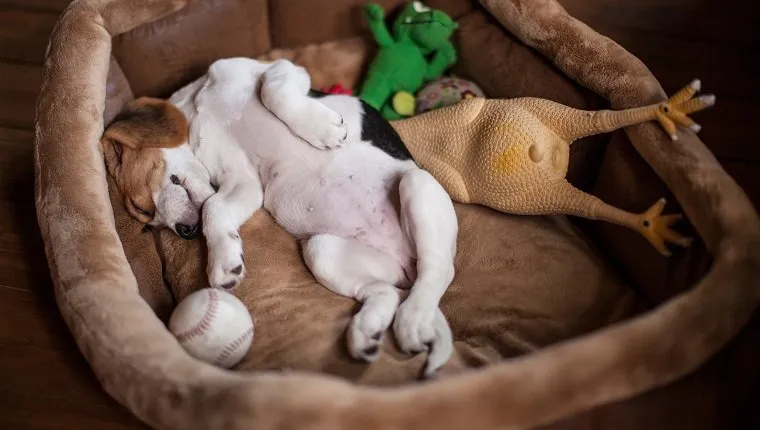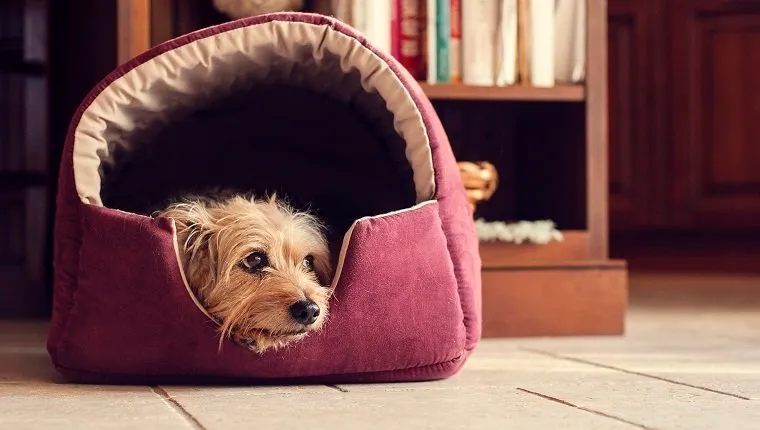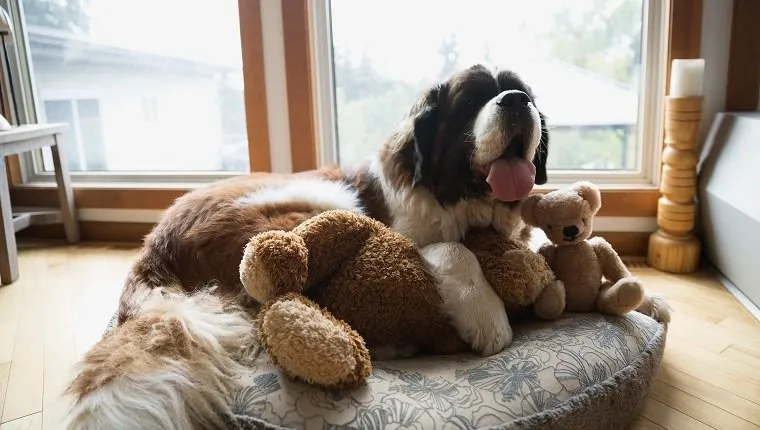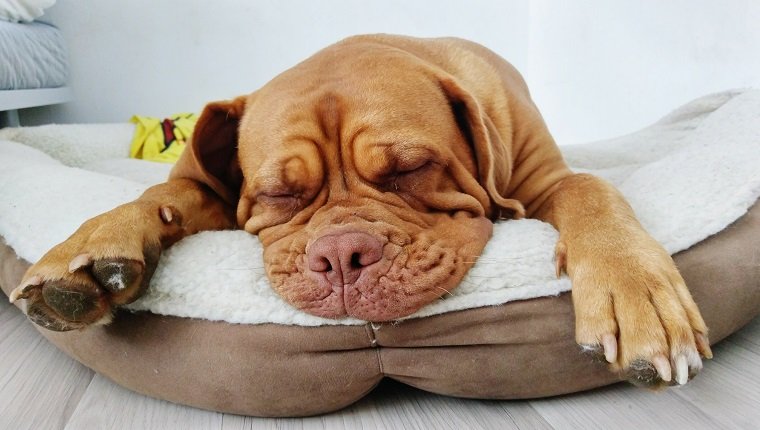Dog beds can be simple or fancy, expensive or homemade, and everything in between.
How do you pick the right dog bed for your pup when there are so many on the market? Does your pooch even need a dog bed? Should you spend a lot of money when your dog is just as happy lying with you in your human bed or on the couch?
These are all questions you should consider before you buy a dog bed, and this dog bed guide is here to help you make a decision.
Does Your Dog Need A Dog Bed?

Even if your dog is allowed to sleep with you in your human bed, every dog should have a bed of their own — or two or three or four, actually.
There are plenty of benefits to having dog beds. They can be used for napping during the day and sleeping in at night.
Unlike the floor, a bed will keep your dog warm, support arthritic joints, and prevent calluses. And unlike a couch or human bed, dog beds are spaces that pups can have all to themselves.
And if you’re allergic to your dogs, then it’s best if they sleep somewhere besides your bed.
Dog beds can also be taken with you when you travel so that your dog feels comfortable and is able to sleep somewhere familiar. They’ll rest easier and feel less anxiety.
Dog beds are also usually easy to wash, which makes life easier if your dog has accidents, gets infested with fleas or mites, or just rolls in something stinky.
A dog bed shouldn’t be used as a place for punishment or confinement. It’s a place of security that belongs only to that one dog, and they should always feel safe in it.
A bed makes a crate more comfortable, but that doesn’t mean a dog can spend twelve hours a day in a crate just because it has a bed. It’s a place dogs should be able to go and relax without feeling trapped or anxious.
All dogs could benefit from having a place where they can feel calm and de-stress during the day or night.
What Kinds Of Dog Beds Are There?

Dog beds can be as simple as your old pillow or as fancy as a wrought-iron frame with a lace canopy. Your selection depends on your taste, budget, and décor, but you may find that your dog expresses a preference by taking over another dog’s bed.
Keep an eye on where your dog feels most comfortable, as this can help you decide which bed will be best.
Basic Styles Of Dog Beds
- Flat pads or mats are inexpensive and fit in crates.
- Nesting/snuggle beds are similar to beanbag chairs and often preferred by smaller dogs who love to curl up.
- Cuddler/nest beds come in the “traditional” oval bowl shape.
- Bolsters have one long side with a built-in pillow and are often preferred by large dogs.
- Donut-shaped beds are circular bolsters with a removable center pillow.
- Waterproof beds are good for outdoor use or incontinent pets.
- Homemade beds can be inexpensive and easy to customize. There are plenty of tutorials on how to make your own dog bed that you can find on YouTube or by searching online. Just make sure you’re using safe materials and that it will hold up, especially if your dog likes to chew.
Special Dog Beds For Seniors Or Dogs With Medical Needs
- Orthopedic beds support old joints or very large dogs; they usually have medical-grade foam and/or box-spring construction.
- Heated beds maintain body warmth. This can be beneficial for dogs who get cold easily or for dogs with arthritis that is worsened by the cold.
- Travel beds are portable, so your dog can have the security of the same bed every night while on the road. For dogs who suffer from anxiety in new places, this can help them relax and get some sleep.
- Cot-style beds keep your dog off the ground and comfortably support joints by distributing the dog’s weight evenly. They are also usually fairly easy to transport.
What Is The Best Dog Bed For Your Dog?

There are so many dog beds on the market. How do you pick the best one? There are many factors to take into consideration, including size, cost, comfort, your dog’s medical needs, convenience, and so much more.
You should do your research and consult your veterinarian about your pup’s needs before you make a decision. Here are several factors to consider when choosing the best dog bed:
- A good fit. Beyond finding something within your budget, make sure your dog fits on the bed; heads and limbs shouldn’t have to be hanging off the edge.
- Easy washability. Dogs eat treats, vomit, pass gas, scratch fleas, and wipe ointment-filled eyes and ears on their beds. Some dogs urinate on them — so the ability to throw the bed into the washing machine is a big help, if not downright critical. Dogs with allergies will also benefit from having their bed washed frequently.
- Safety. Place the bed away from high-traffic areas so no one trips on it or on the dog. If the dog chews it, then get rid of it — swallowing stuffing can lead to emergency surgery (and you thought the bed itself was expensive). Remove any buttons or ribbons the dog could chew, or look for “chew-proof” beds now available.
- Stuffing that works for you and your dog. Young, warm, healthy dogs can usually get by with inexpensive foam filling, but your older or arthritic dog will probably prefer more comfort and support. Some orthopedic beds use foam because it’s thicker and of higher quality, so it doesn’t squash flat. Thick, flexible gel has recently become more common as a bed filling; it’s more comfortable than foam and distributes weight more evenly, making it excellent for geriatric dogs — but expensive. And some beds contain cedar chips to ward off pests and keep the bed smelling fresher than your dog.
- The environment. Some of us are concerned about using materials that won’t harm the earth when we decide to replace, get rid of, or recycle a dog bed. You can check out eco-friendly dog beds if that’s something that factors into your decision.
- Absorbent pads for dogs who wet the bed. Sick, incontinent, or geriatric dogs can benefit from washable or disposable absorbent pads (technically, you’re the one benefiting because you won’t have to wash the bed). Note: These flat pads won’t fit well in a nesting bed.
Dog Bed Reviews

You should definitely do your own research and check with your veterinarian so you can be sure that you’re addressing all of your dog’s needs.
Our amazing doggy reviewers at DogTime are always happy to try out a nice, comfy, new bed and give us their opinions with wags of the tail or turned noses.
These reviews might help you make a decision on which is the best dog bed for your pup. Click below to check out each review and decide for yourself which bed is best:
What factors are important to you when choosing a dog bed? How many dog beds does your pup have? Let us know in the comments below!
Click the bold links in the article to shop for your dog and support our content!









